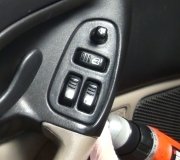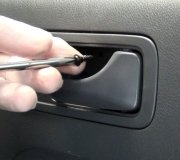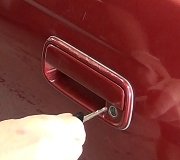Hi and thanks for using 2CarPros.
I hate to say it, but the tests related to power windows is extensive. However, here they are. This is related to all conditions.
DIAGNOSIS AND TESTING - POWER WINDOWS
Following are tests that will help to diagnose the hard wired components and circuits of the power window system. However, these tests may not prove conclusive in the diagnosis of this system. In order to obtain conclusive testing of the power window system, the Programmable Communications Interface (PCI) data bus network and all of the electronic modules that provide inputs to, or receive outputs from the power window system components must be checked.
The most reliable, efficient, and accurate means to diagnose the power window system requires the use of a DRB scan tool and the proper Diagnostic Procedures manual. The DRB scan tool can provide confirmation that the PCI data bus is functional, that all of the electronic modules are sending and receiving the proper messages on the PCI data bus, and that the power window motors are being sent the proper hard wired outputs by the door modules for them to perform their power window system functions.
For complete circuit diagrams, refer to the appropriate wiring information. The wiring information includes wiring diagrams, proper wire and connector repair procedures, details of wire harness routing and retention, connector pin-out information and location views for the various wire harness connectors, splices and grounds.
ALL WINDOWS INOPERATIVE
1. Check the operation of the power lock switch on the driver side front door. If all of the doors lock and unlock, but none of the power windows operate, use a DRB scan tool and the proper Diagnostic Procedures manual to check the Body Control Module (BCM), the Driver Door Module (DDM) and the PCI data bus for proper operation. If not OK, go to Step 2.
2. Check the operation of the power lock switch on the passenger side front door. If the passenger doors lock and unlock, but the driver side front door does not, go to Step 5. If all of the power locks and power windows are inoperative from both front doors, go to Step 3.
3. Check the fused B(+) fuse in the Power Distribution Center (PDC). If OK, go to Step 4. If not OK, repair the shorted circuit or component as required and replace the faulty fuse.
4. Check for battery voltage at the fused B(+) fuse in the PDC. If OK, go to Step 5. If not OK, repair the open fused B(+) circuit to the battery as required.
5. Disconnect and isolate the battery negative cable. Remove the trim panel from the driver side front door. See: Front Door Panel > Service and Repair Disconnect the 15-way door wire harness connector from the DDM connector receptacle. Check for continuity between the ground circuit cavity of the 15-way door wire harness connector for the DDM and a good ground. There should be continuity. If OK, go to Step 6. If not OK, repair the open ground circuit to ground as required.
6. Reconnect the battery negative cable. Check for battery voltage at the fused B(+) circuit cavity of the 15-way door wire harness connector for the DDM. If OK, replace the faulty DDM. If not OK, repair the open fused B(+) circuit to the fuse in the PDC as required.
PASSENGER SIDE FRONT AND REAR WINDOWS INOPERATIVE
If the driver side front and rear power windows operate, but the passenger side front and rear do not, use a DRB scan tool and the proper Diagnostic Procedures manual to check the PCI data bus for proper operation.
ONE WINDOW INOPERATIVE
The window glass and regulator mechanism must be free to slide up and down for the power window motor to function properly If the window glass and regulator is not free to move up and down, the motor will overload and trip the integral circuit breaker. To determine if the window glass and regulator are free, disconnect the regulator plate from the glass. Then slide the window up and down by hand.
There is an alternate method to check if the window glass and regulator mechanism is free. Position the glass between the up and down stops. Then, shake the glass in the door. Check that the glass can be moved slightly from side to side, front to rear, and up and down. Then check that the glass is not bound tight in the tracks.
If the window glass and regulator mechanism is free, refer to Door Module in Electrical, Power Windows. If the glass is not free, inspect the window glass mounting and operating hardware for damage or improperly installed components. Refer to Body to check for proper installation or damage of the window glass mounting and operating hardware.
DOOR MODULE
NOTE: The following tests may not prove conclusive in the diagnosis of this component. The most reliable, efficient, and accurate means to diagnose this component requires the use of a DRB scan tool and the proper Diagnostic Procedures manual.
If the problem being diagnosed is a rear door window that does not operate from the rear door switch, but does operate from the master switch on the driver side front door, refer to Power Window Switch Diagnosis and Testing. If the problem is a passenger side front or rear window that operates from the switch on that door, but does not operate from the master switch on the driver side front door, use a DRB scan tool and the proper Diagnostic Procedures manual to diagnose the circuitry of both door modules and the PCI data bus. For complete circuit diagrams, refer to the appropriate wiring information. The wiring information includes wiring diagrams, proper wire and connector repair procedures, details of wire harness routing and retention, connector pin-out information and location views for the various wire harness connectors, splices and grounds.
1. Disconnect and isolate the battery negative cable. Remove the trim panel from the front door See: Front Door Panel > Service and Repair, but do not disconnect the door wire harness connectors from the door module. Go to Step 2.
2. Check the 15-way door wire harness connector for the door module to see that it is fully seated in the door module connector receptacle. If OK, go to Step 3. If not OK, properly connect the 15-way door wire harness connector for the door module to the door module connector receptacle.
3. Disconnect the 15-way door wire harness connector from the door module connector receptacle. Check for continuity between the ground circuit cavity of the 15-way door wire harness connector for the door module and a good ground. There should be continuity. If OK, go to Step 4. If not OK, repair the open ground circuit to ground as required.
4. Connect the battery negative cable. Check for battery voltage at the fused B(+) circuit cavity of the 15-way door wire harness connector for the door module. If OK, go to Step 5. If not OK, repair the open fused B(+) circuit to the fuse in the Power Distribution Center (PDC) as required.
5. If the inoperative window is on a front door, go to Step 6. If the inoperative window is on a rear door go to Step 9.
6. Disconnect and isolate the battery negative cable. Disconnect the door wire harness connector from the inoperative power window motor wire harness connector. Check for continuity between the front window driver up circuit cavity of the 15-way door wire harness connector for the door module and a good ground. Repeat the check for the front window driver down circuit. In each case there should be no continuity. If OK, go to Step 7. If not OK, repair the shorted front window driver up or down circuit as required.
7. Check for continuity between the front window driver up circuit cavities of the 15-way door wire harness connector for the door module and the door wire harness connector for the power window motor. Repeat the check for the front window driver down circuit. In each case there should be continuity. If OK, go to Step 8. If not OK, repair the open front window driver up or down circuit as required.
8. Reconnect the 15-way door wire harness connector back into the door module connector receptacle. Connect the battery negative cable. Connect the probes of a reversible DC digital voltmeter to the door wire harness connector for the power window motor. Observe the voltmeter while actuating the switch for that window in the up and down directions. There should be battery voltage for as long as the switch is held in both the up and down positions, and no voltage in the neutral position. If OK, refer to Window Motor Diagnosis and Testing. If not OK, replace the faulty door module.
9. Check the rear door power window switch continuity. If OK, go to Step 10. If not OK, replace the faulty rear door power window switch.
10. Disconnect and isolate the battery negative cable. Reconnect the door wire harness connector to the rear door power window switch. Disconnect the door wire harness connector from the inoperative power window motor wire harness connector. Check for continuity between the rear window driver up circuit cavity of the 15-way door wire harness connector for the door module and a good ground. Repeat the check for the rear window driver down circuit. In each case there should be no continuity. If OK, go to Step 11. If not OK, repair the shorted rear window driver up or down circuit as required.
11. Check for continuity between the rear window driver up circuit cavities of the 15-way door wire harness connector for the door module and the power window motor wire harness connector. Repeat the check for the rear window driver down circuit. In each case there should be continuity. If OK, go to Step 12. If not OK, repair the open rear window driver up or down circuit as required.
NOTE: The door module feeds battery current to both terminals of the rear door power window motors when the power window lockout switch is in the Unlock position, until the master window switch on the driver side front door is actuated. The door module feeds ground to both terminals of the rear door power window motor when the power window lockout switch is in the Lock position, until the master window switch on the driver side front door is actuated.
12. Reconnect the 15-way door wire harness connector for the door module to the door module connector receptacle. Connect the battery negative cable. Check for battery voltage at each cavity in the door wire harness connector for the power window motor. Each cavity should have battery voltage when the power window switch is in the neutral position. Each cavity should also have battery voltage in one other switch position, either up or down, and zero volts with the switch in the opposite position. If OK, refer to Window Motor Diagnosis and Testing. If not OK, replace the faulty door module.
___________________________________
Let me know if I can help. I know this is extensive.
Joe
Saturday, March 2nd, 2019 AT 6:35 PM



